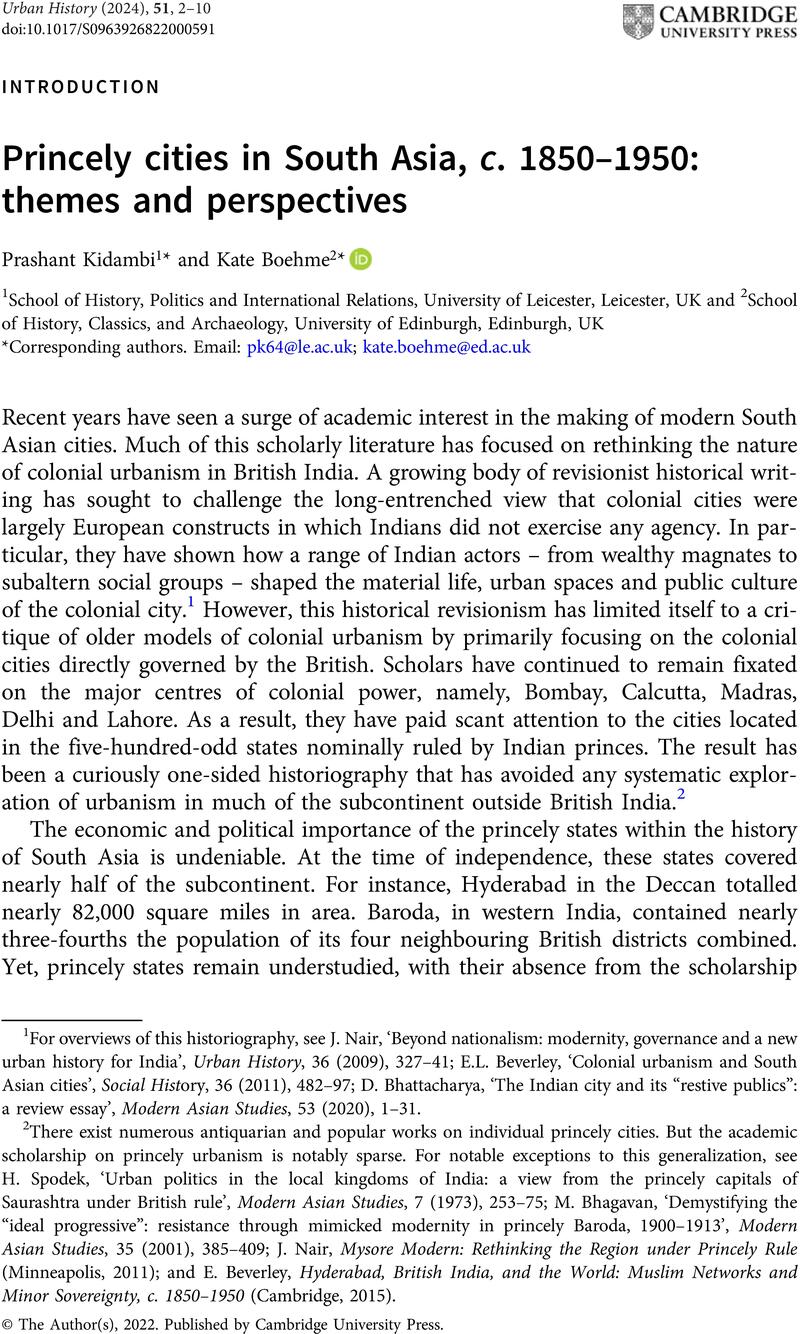No CrossRef data available.
Article contents
Princely cities in South Asia, c. 1850–1950: themes and perspectives
Published online by Cambridge University Press: 17 November 2022
Abstract

- Type
- Introduction
- Information
- Copyright
- © The Author(s), 2022. Published by Cambridge University Press
References
1 For overviews of this historiography, see Nair, J., ‘Beyond nationalism: modernity, governance and a new urban history for India’, Urban History, 36 (2009), 327–41Google Scholar; Beverley, E.L., ‘Colonial urbanism and South Asian cities’, Social History, 36 (2011), 482–97CrossRefGoogle Scholar; Bhattacharya, D., ‘The Indian city and its “restive publics”: a review essay’, Modern Asian Studies, 53 (2020), 1–31Google Scholar.
2 There exist numerous antiquarian and popular works on individual princely cities. But the academic scholarship on princely urbanism is notably sparse. For notable exceptions to this generalization, see Spodek, H., ‘Urban politics in the local kingdoms of India: a view from the princely capitals of Saurashtra under British rule’, Modern Asian Studies, 7 (1973), 253–75Google Scholar; Bhagavan, M., the, ‘Demystifying “ideal progressive”: resistance through mimicked modernity in princely Baroda, 1900–1913’, Modern Asian Studies, 35 (2001), 385–409Google Scholar; J. Nair, Mysore Modern: Rethinking the Region under Princely Rule (Minneapolis, 2011); and E. Beverley, Hyderabad, British India, and the World: Muslim Networks and Minor Sovereignty, c. 1850–1950 (Cambridge, 2015).
3 The papers included in this volume were presented a workshop entitled ‘Princely cities: towards a new history of urban South Asia’, held at the Centre of Urban History, University of Leicester, on 8–9 April 2019.
4 Beverley, ‘Beyond colonial urbanism’.
5 Ibid.
6 Cohen, ‘Class, place, and power’.
7 Krishna, ‘Going to the cinema’.
8 Nair, ‘Monarchical modern’.
9 Ibid.
10 Ibid.
11 Ibid.
12 Dhabhai, ‘Sovereign dreams and bureaucratic strategies’.
13 Ibid.
14 Boehme, ‘Princely urbanism and the colonial city’.
15 Here, Boehme's work resonates with Beverley's article in this collection, which dwells on the significance of Hyderabad Estate in Bombay's highly sought after Malabar Hill district. The Nizam had purchased this property in 1909, in a neighbourhood dominated by the residences of a number of other Indian princes. In the 1920s, the land became the focus of fractious litigation. The Nizam's lawyers sought to uphold Hyderabadi legal norms in defending its status as a waqf property. In the process, Beverly argues, they ‘introduced different legal rationalities and historical practices that open up spaces for thinking about property tenures in colonial cities’. Beverley, ‘Beyond colonial urbanism’.
16 States such as Baroda, Hyderabad and Mysore undeniably feature especially prominently in the literature on princely states. See, for example, Kooiman, D., Communalism and Indian Princely States: Travancore, Baroda and Hyderabad in the 1930s (New Delhi, 2002)Google Scholar; Pernau, M., The Passing of Patrimonialism: Politics and Political Culture in Hyderabad, 1911–1948 (Delhi, 2000)Google Scholar; Manor, J., Political Change in an Indian State: Mysore, 1917–1955 (New Delhi, 1977)Google Scholar; Hettne, B., The Political Economy of Indirect Rule: Mysore, 1881–1947 (London, 1978)Google Scholar.





